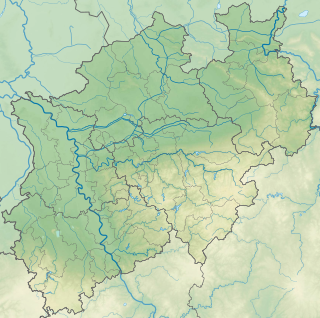Selbecker Terrassenland
| Selbecker Terrassenland | |||
|---|---|---|---|
| Systematics according to | Handbook of the natural spatial structure of Germany | ||
| Greater region 1st order | Low mountain range threshold | ||
| Greater region 2nd order | Rhenish Slate Mountains | ||
| Main unit group | 33 → Süderbergland |
||
| About main unit | 337 → Bergisch-Sauerland lowlands |
||
| 4th order region (main unit) |
337 1 → Niederbergisch-Märkisches hill country |
||
| 5th order region | 337 1 .0 → Niederbergische Höhenterrassen |
||
| Natural space |
337 1 .03 → Selbecker Terrassenland |
||
| Geographical location | |||
| Coordinates | 51 ° 21 '22 " N , 6 ° 53' 20" E | ||
|
|||
| local community | Ratingen , Mülheim an der Ruhr | ||
| state | North Rhine-Westphalia | ||
| Country | Germany | ||
With Selbecker terrace country one is natural spatial unit (order number 337 1 .03) of the main unit via Bergisch-Sauerländisches lowlands called (atomic number 337).
It covers parts of the urban area of Ratingen ( Breitscheid , Mintarder Berg district ) and Mülheim an der Ruhr ( Saarn district with the eastern Selbeck ). In the north and east, the Terrassenland is naturally bounded by the Ruhr Valley (order number 337 1 .2) and in the south by the Mettmanner Loess Terraces (337 1 .00). In the west it goes over to the main unit Bergische Heideterrasse (550).
The Selbecker Terrassenland consists of a loess-free main terrace area at a height of approx. 100 m , which has sunk to 70 m in the north and west due to recent tectonic movements. Remains of older terraces and terminal moraines from the Ice Age are to be found in the east of the natural area. They rise up to 118 m in height as gravel and sand dome . Behind it, the terrain drops steeply into the Ruhr valley as a collision slope of the Kettwig Ruhr arc.
Geologically, the subsoil of the site consists of folded Upper Carboniferous rocks, especially greywacke , slate , sandstones and quartzites . The shallow weathered soils on the slopes are sandy-loamy. In the natural area, agriculture is mainly practiced on the cleared terrace areas. The slopes and crests , on the other hand, are wooded.
